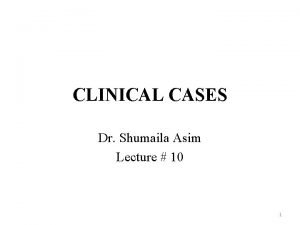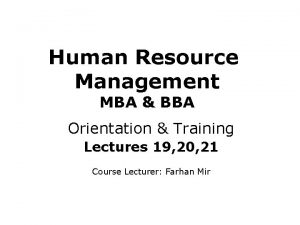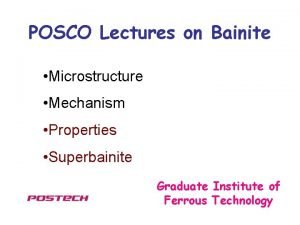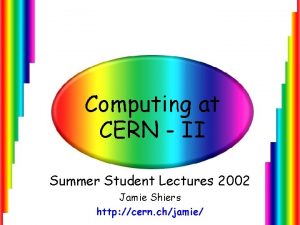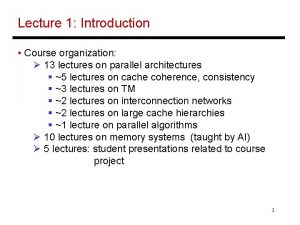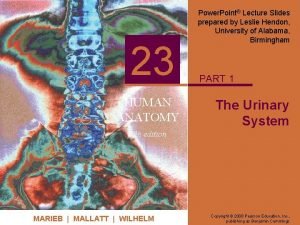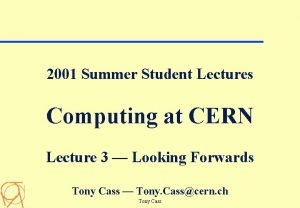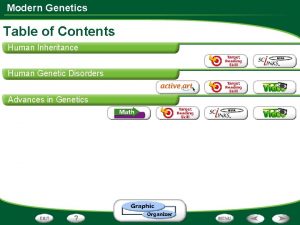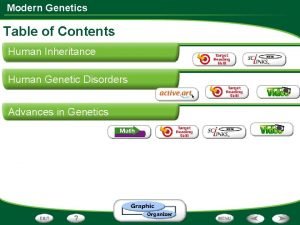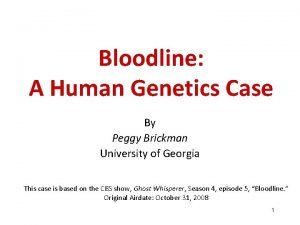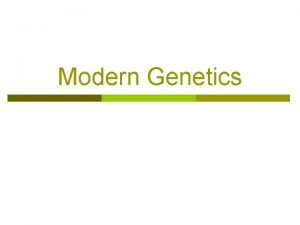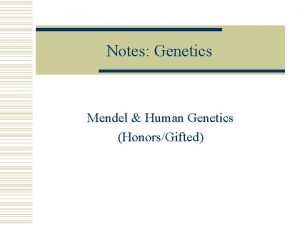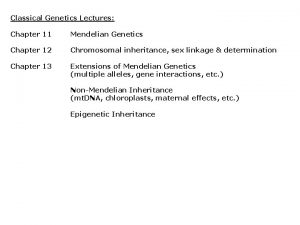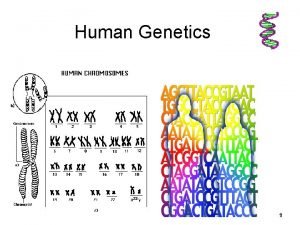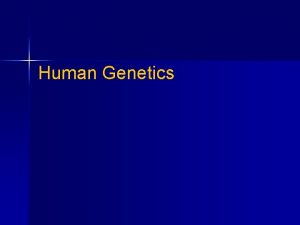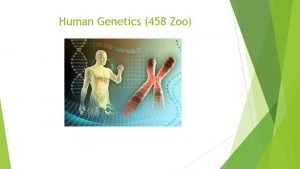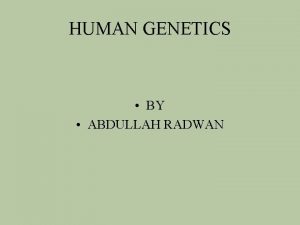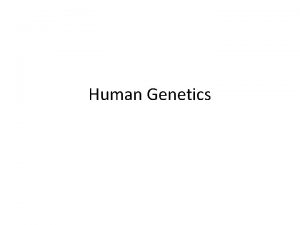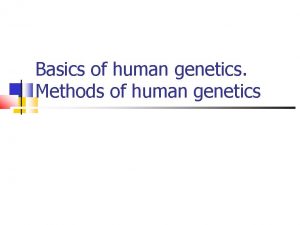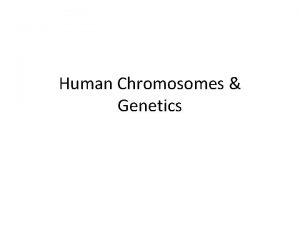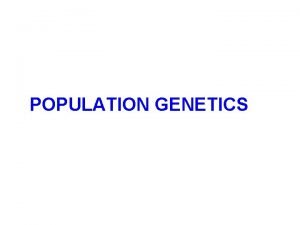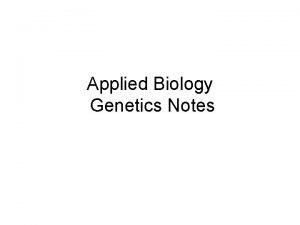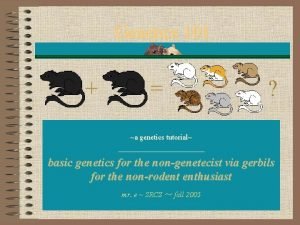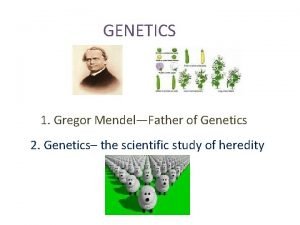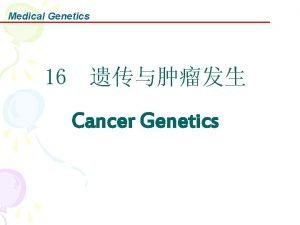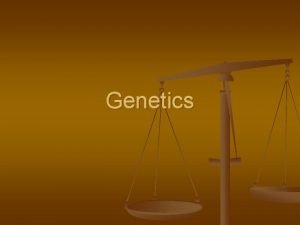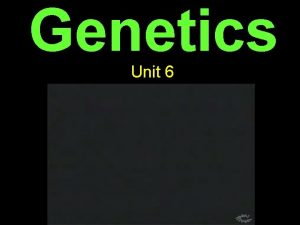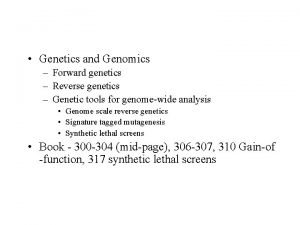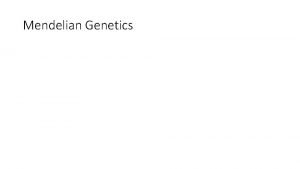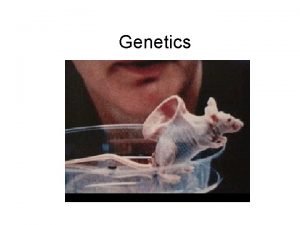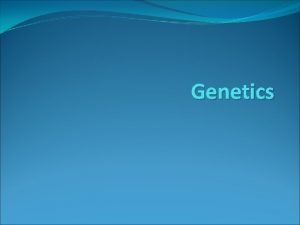Human genetics Human genetics Lectures 17 x 2
























































- Slides: 56

Human genetics

Human genetics • Lectures – 17 x 2 (Med); 17 x 1 (Stom); • Seminars – 17 x 3 (Med); 17 x 2 (Stom); – 3 concluding tests (tests + practical part) – Final examination (tests + practical part) – Consultations – www. biologiemoleculara. usmf. md – http: //e. usmf. md – Passkey – bmgu 2

Average mark • • Written test 1 (max. 10) Computer test 1 (max. 10) Written test 2 (max. 10) Computer test 3 (max. 10) Attendance in lectures (max. 10) Scientific report (max. 10, for Med only)

Final grade • Average per semester – 50% • Written (practical) part – 30% • Multiple choice test – 20%

Agricultural revolution – XVII-XVIII century Industrial revolution – XIX century Informational revolution – XX century Genetic revolution – XXI century 5

Development of Human and Medical genetics • 1956 – identification of number of human chromosomes (46, XX; 46, XY); • 1961 - relationship between chromosomal aberrations and human diseases; • 1966 – decoding of genetic code, description of inherited metabolic diseases; prenatal diagnosis via amniocentesis. • 1980 – cloning of first human gene. 6

• 1981 - molecular methods used for location of genes in chromosomes. • 1985 - PCR used for identification of mutations. • 1991 – cloning of genes involved in many human diseases: Dushenne muscle distrophy, cystic fibrosis, neurofibromatosis, retinita pigmentosum, Marfan sdr. 7

• 1994 – Mc. Kusick published „Mendelian Inheritance in Man; A Catalog of Human Genes and Genetic Disorders”. On-line version OMIM http: //www. ncbi. nlm. nih. gov/omim/ • 1996 – preimplantation diagnostic of embryos obtained by in vitro fertilisation. • 1996 - 2001 more then 1000 genes involved in human pathology were described. 8

In 2001 „Human genome project” starts. During 2001 -2003 many visions were changed: – From structure – to function of genes; – From location of genes in chromosomes – to sequencing of DNA; – From diagnostic of genetic diseases – to calculation of predisposition to genetic diseases; – From etiology – to mechanisms; – From analysis of monogenic traits – to analysis of polygenic traits; – From genome – to proteome; – From medical genetics – to genetic medicine; 9

Cell Chromosomes Organism Nucleus Protein Amino acids DNA 10

The “omics” cascade DNA • Genome RNA • Transcriptome Proteins • Proteome Amino acids Lipids ATP etc. • Metabolome Nervous system, Cardio-vascular system Muscular system, etc. • Phenome

CLASSIC VISION GENETIC VISION Why this patient has this disease now? What is the problem? Patient What to do in order to solve this problem? What possibilities are for prevention or reducing of effect of disease for patient or/and his family? Which is the prognostic and prophylaxis of complications in this patient? What is the risk for this disease for other members of the family?

Prenatal diagnostic Prognosis of disease evolution New methods of diagnostic Understanding of etiopathology Preimplantation diagnostic How does genetics benefit medicine? Family planning Cell therapy New etiopathological drugs Gene therapy 13

Compartments of genetics Clinical genetics Medical genetics Human genetics

Human genetics – Fundamental and applicative science Genetics is fundamental science because it is studying: • structure, • main mechanisms, • main principles, - which ensure keeping, transmission and expression of human traits, - which ensure formation, development and functions of human organism. 15

Genetics is a clinic science Which study relationships between heredity and diseases: - mutations (monogenic, polygenic or chrs) determine * a disease or * a predisposition for a genetic disease. - Genetic diseases are: * numerous - 9000; * frequent - 5 -8% in newborns. - Genetic diseases are present in all medical fields. 16

Lymphocytes – 374 Endothelial cells – 1031 Salivary glands – 17 Thyroid gland – 584 Parathyroid glands – 46 Smooth muscle – 127 Brain – 3195 genes Eye – 547 genes Bons – 904 genes Adipose tissue – 581 genes Thymus – 261 genes Esophagus – 76 genes Lungs – 1887 genes Genes involved in human development and functions of tissues and organs Skeletal muscle – 735 Mammal glands – 696 Pancreas – 1094 Spleen – 1094 Adrenal glands – 658 Gallbladder – 788 Small intestine – 297 Placenta – 1290 Prostate – 1283 Leucocytes – 2164 Skin – 620 Heart – 1195 genes Liver – 2091 genes Erythrocyte – 8 genes Trombocytes – 22 genes Large intestine – 874 genes Kidney – 712 genes Ovary – 504 genes Testis – 370 genes Uterus – 1859 genes Embryo – 1989 genes Synovial membrane – 813 genes 17

Genetics is a science which study: - heredity and - variability of human organism. Substrate of heredity and variability: Molecular Morphologic Cellular DNA Chromosomes Genetic apparatus 18

Heredity • Heredity is the passing of traits to offspring (from its parent or ancestors). This is the process by which an offspring cell or organism acquires or becomes predisposed to the characteristics of its parent cell or organism.

Heredity is based on Keeping of genetic information (GI) in DNA • Genetic code is universal • There are systems for DNA repair in case of errors • GI is stored as chromatin or chromosomes. Expression of GI Passing of GI • DNA → RNA → polypeptide → protein → phenotype • Based on the principles of genetic code • Programmed in time and space • Modified by environment • 1 gene controls one or several traits • 1 trait is determined by one or several genes • Determined by semiconservative replication of the DNA • Equal distribution of chromosomes during cell division • Combination of maternal and paternal genomes during fecundation

Importance of heredity Biological importance • Keeping of family traits • Keeping of population peculiarities • Species conservation Medical importance • Familial aggregation of genetic diseases, genetic predisposition to diseases • Establishing of groups of high risk for some genetic disorders • Prenatal or pre-symptomatic genetic testing • Prevention of diseases in relatives in families with high risk • High susceptibility to infectious agents in particular families • Characteristic population frequency for genetic diseases

Variability Genetic variability is a measure of the tendency of individual genotypes in a population to vary from one another. • Could be hereditary or non-hereditary. • Could be induced by modifications in genetic material modification of phenotype.

Importance of variability: Medical importance Biological importance • Each person is unique; • Natural selection during permanent interaction with environment; • Different response to environment (food, toxins. . . ); • Predisposition to some diseases (cancer, diabetes, hypertension. . . ); • Different manifestation of disease in different patients; • Different response to drugs in different patients with the same disease. • !!! Individual medicine

Variability Human organism Genotype Modifications in genetic material Mutational Gene / chromosomal / genomic mutations Combinative Intra- / inter-chromosomal / genomic recombination + migration Phenotype Modification of traits only Modifications Ontogenetic / adaptive / destructive changes

Mutations • Unexpected, accidental, permanent changes which occur in the structure of the genetic material of an organism May affect • Nuclear genome • Mitochondrial genome May alter • The whole genome (polyploidy or aneuploidy), • One or several chromosomes (balanced or unbalanced chromosomal aberrations); • One or several nucleotides (gene, point mutations)

All pathologies have a genetic component Mutations (modifications of genetic material) Responsible for a disease / syndrome Responsible for predisposition to a disease Change resistance against infectious agents Change the metabolism of drugs Influence the regeneration of tissues Etc. 26

• Genetic diseases are numerous. • There are known over 10. 000 of disease determined or conditioned by genetic factors. • Are highly diverse. • May appear at any age. • May affect any organ present in all fields of medicine. • Present in 5 -8% of newborns. • Genetic factors may be responsible for reproductive disorders (sterility, miscarriage). • Genetic diseases responsible for infantile mortality and morbidity. • Genetic diseases are chronic diseases and produce physical or mental disorders. 27

Causes of mutations Spontaneous Induced IRRADIATIONS CHEMICALS VIRUSES

Types of mutations Genomic Polyploidies (3 n) Aneuploidies (2 n± 1) Chromosomal Deletions Duplications Inversions Translocations Iso-chromosomes Gene Substitutions Deletions Duplications Insertions

Frequency of genetic disorders 10% Polygenic diseases Monogenic diseases 2% Chromosomal syndromes 0, 7% 0% 5% 10% 15% 30

Genetic diseases Chromosoma l syndromes Types Aneuploidies l > 1000 Chromosomal aberrations Autosomal dominante Monogenic diseases l > 9000 Autosomal recesive X-linked Mitochondrial Examples 47, XX, +21 – (Down sdr. ); 47, XXY – (Klinefelter sdr. ); 45, X – (Turner sdr. ); Del, dup, izo, r; ex: cri du chat sdr. ; Wolf-Hirschhorn sdr. ; Di. George sdr. ; Williams sdr. FH, ADPKD, neurofibromatosis 1, Marfan sdr. , Huntington disease, breast cancer, colon cancer Phenylketonuria, cystic fibrosis, sickle cell anemia, albinism Hemophilia, muscle dystrophy, color blindness Leber neuropathy Diabetes, hypertension, obesity, cancers Adult diseases Polygenic diseases l > 100 Isolated malformations in children Defects of neural tube, cleft lips, heart congenital malformations 31

Types of mutations Generative Somatic • Homogeneous – alter all cells in the body • Are inherited via gametes • May be expressed by offspring • • In mosaic – alter just groups of cells, a mutant cell clone will appear Are produced after fecundation May be expressed by holder Cannot be inherited

Mutations Expression of mutations in phenotype Lethal Semi-lethal Neutral Benignant

Gene Intra-chromosomal • Crossing-over • Prophase I Recombination of genetic material Inter-chromosomal Genomic • Independent segregation of chromosomes • Anaphase I • During fecundation

Migration Movement of genes from one population to another Modification of gene pool Modification of frequency of some normal genes vs. pathologic Modification of frequency of some genetic diseases ↑or↓

Phenotype variability Ontogenic modifications Adaptive modifications in the limit of norm of reaction Pathologic modifications out of norm of reaction Acquired modifications Phenocopies

Adaptive modifications in the limit of norm of reaction • Norm of reaction is under control of genotype • Under the pressure of environment gene expression changes to ensure optimal activity of organism – Short-time adaptations – Long-time adaptations

Spontaneous abnormalities induced by environment • Abnormalities produced during development caused by destructive factors • Congenital abnormalities – Determined by teratogen factors – Mime genetic disorders PHENOCOPIES • Postnatal abnormalities

Genetic apparatus of human cell Genetic material Cell components which ensure activity 46 mol. 2 -10 mol. DNA mt. DNA Chrs Realization Transmission of GI Apparatus of transcription Apparatus of translation Apparatus of replication Apparatus of mitosis

Levels of organization of genetic material I. Genome – complement of cell DNA (nuclear + mitochondrial) II. Chromosome – a linkage group of genes III. Gene – elementary unit responsible for synthesis of a protein and expression of a trait 40

Non-coding sequences Regulatory sequences GENOTYPE Coding sequences HUMAN GENOME ~30000 pairs of genes

Peculiarities of the human genome Haploid nuclear genome Mitochondrial genome 3, 2 x 109 bp 16, 6 kb ~ 30000 genes 37 genes Gene DNA Extra-gene DNA 25% 75% Coding DNA 10% Non-coding DNA 90% Single copy or low number copies sequences Moderate or highly repetitive sequences 60% 42

43

Sequences of the Human genome • Structural genes • r. RNA genes • t. RNA genes • micro. RNA genes • Transposons • Retrotranspososns • Viral DNA • Pseudogenes • Enhancers • Silancers CODING REGULATORY FACULTATIVE NON-CODING OBLIGATORY NON-CODING • ARS (ORI) • Centromere DNA • Telomere DNA • Palindromes • Spacers

Alternation of genome elements • • • Structural genes Coding sequence in tandem (e. g. , Nucleolar organizer) Spacers Satellite DNA (e. g. , centromeric DNA) LINEs (Long Interspersed Repeated Elements) – 16% SINEs (Short Interspersed Repeated Elements) – 11% LTRs (Long Terminal Repeats) VNTRs (Variable Number Tandem Repeats) SSRs (Simple Sequence Repeats) etc.

Repetitive elements in human gene HGO (homogentisate 1, 2 -dioxygenase) Deficiency of enzyme encoded by HGO leads to alkaptonuria

Human chromosomes • morphologic substrate of H and V; • supramolecular level of organization of genetic material (DNA + histones + non-histones + RNA) • dynamic structures with different shape, level of condensation, gene activity: • single-chromatid or two-chromatid; • chromatin or chromosome; • transcriptional active or inactive. 47

• self-reproduction of chromosomes takes place during S phase of interphase (replication). • chromosomes represent linkage groups of genes: - each chrs contains a specific number of genes; - each gene has a specific place in chrs - locus; - genes of one chromosome are inherited together • a diploid set of chromosomes is called karyotype: 23 pairs: 22 pairs of autosomes + 1 pair of gonosomes (XX or XY). Pair of chromosomes = homolougus chromosomes 48

Origin of gonosomes 49

• landmarks of karyotype: relative and absolute length of chrs, position of centromere = primary constriction - c, presence of secondary constrictions - h, presence of satellites - s • chromosomes may be analyzed during: • metaphase (homogenous painting or banding) • prometaphase (banding) • interphase (hybridization with fluorescent probes) 50

• chromosomes have heterogeneous structure: - Coding and non-coding sequences; - euchromatin and heterochromatin, - single copy and repetitive sequence; -GC and AT reach sequences; - transcribed and non-transcribed sequences; - sequences associated with basic and basic proteins. !!! This explains origin of chromosomal bands • Chromosomal number and structural abnormalities induce developmental abnormalities - sundromes 51

Structure of metaphase chromosomes. Rchromosomal landmarks Satellite Secondary constriction Centromere Primary constriction Sister chromatids The shape of chromosome depends on position of centromere 52

53

Human karyotype 54

Classification of chromosomes By length: By shape: By type: -Large -Metacentric -Autosomes -Medium -Submetacentric -Gonosomes -Small -Acrocentric By presence of other landmarks: Groups: A 1 -3 E 16 -18 -h on p arm B 4, 5 F 19, 20 -h on q arm C X, 6 -12 G 21, 22, Y -satellites D 13 -15 55

Human karyotype and chromosomal formula 46, XX 46, XY 47, XXY 45, X 47, XY, +21 45, XY, -21 46, XX, 5 p- 56
 Hugh blair lectures on rhetoric
Hugh blair lectures on rhetoric Dr asim lectures
Dr asim lectures Bba lectures
Bba lectures Cdeep lectures
Cdeep lectures Radio astronomy lectures
Radio astronomy lectures Haematology lectures
Haematology lectures What is text linguistics
What is text linguistics Lectures paediatrics
Lectures paediatrics Bhadeshia lectures
Bhadeshia lectures Reinforcement learning lectures
Reinforcement learning lectures Do words have power
Do words have power Cs614 short lectures
Cs614 short lectures What is hegelian philosophy
What is hegelian philosophy Aerodynamics lecture
Aerodynamics lecture Ota core curriculum
Ota core curriculum Medical emergency student lectures
Medical emergency student lectures Oral communication 3 lectures text
Oral communication 3 lectures text Dr sohail lectures
Dr sohail lectures Bureau of lectures
Bureau of lectures Theory of translation lectures
Theory of translation lectures Data mining lectures
Data mining lectures Yelena bogdan
Yelena bogdan Cern summer student lectures
Cern summer student lectures Frcr physics lectures
Frcr physics lectures 13 lectures
13 lectures Planning a software project
Planning a software project Nuclear medicine lectures
Nuclear medicine lectures Theory of translation lectures
Theory of translation lectures Anatomy lectures powerpoint
Anatomy lectures powerpoint Hematology
Hematology C programming lectures
C programming lectures Utilities and energy lectures
Utilities and energy lectures Slagle lecture
Slagle lecture Digital logic design lectures
Digital logic design lectures Medicinal chemistry lectures
Medicinal chemistry lectures Cs106b lectures
Cs106b lectures Comsats virtual campus lectures
Comsats virtual campus lectures Pathology lectures for medical students
Pathology lectures for medical students Frcr physics lectures
Frcr physics lectures Reinforcement learning lectures
Reinforcement learning lectures Molecular biology lectures
Molecular biology lectures Recursive fractals c++
Recursive fractals c++ Power system lectures
Power system lectures Rick trebino lectures
Rick trebino lectures Cern summer school lectures
Cern summer school lectures Rcog eportfolio
Rcog eportfolio Introduction to web engineering
Introduction to web engineering Theory of translation lectures
Theory of translation lectures Kurose ross computer networking
Kurose ross computer networking Uva powerpoint
Uva powerpoint Differentiation of rbc
Differentiation of rbc Human inheritance modern genetics answer key
Human inheritance modern genetics answer key Introduction to genetic analysis tenth edition
Introduction to genetic analysis tenth edition Genetics graphic organizer
Genetics graphic organizer Bloodline a human genetics case answer key
Bloodline a human genetics case answer key Modern genetics human inheritance answer key
Modern genetics human inheritance answer key Section 14-3 human molecular genetics answers
Section 14-3 human molecular genetics answers

